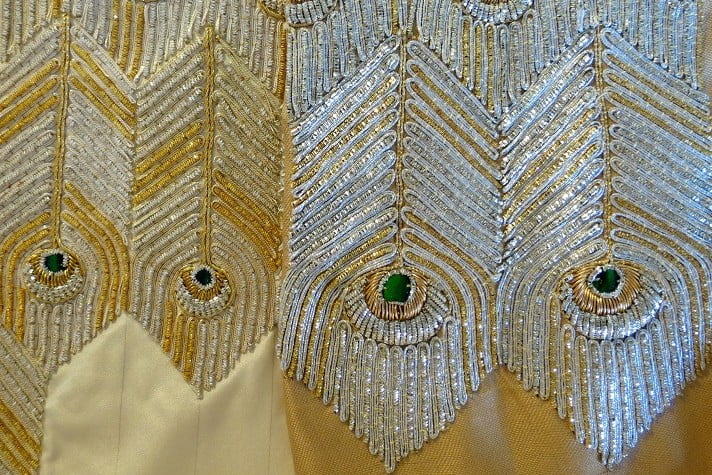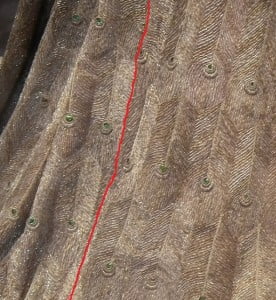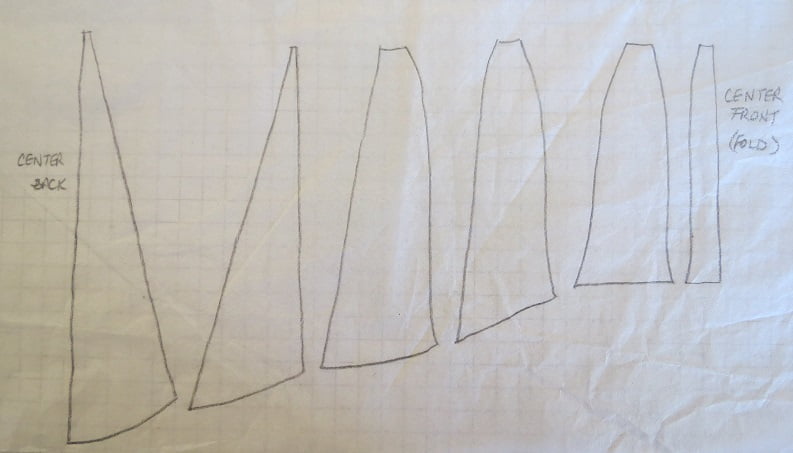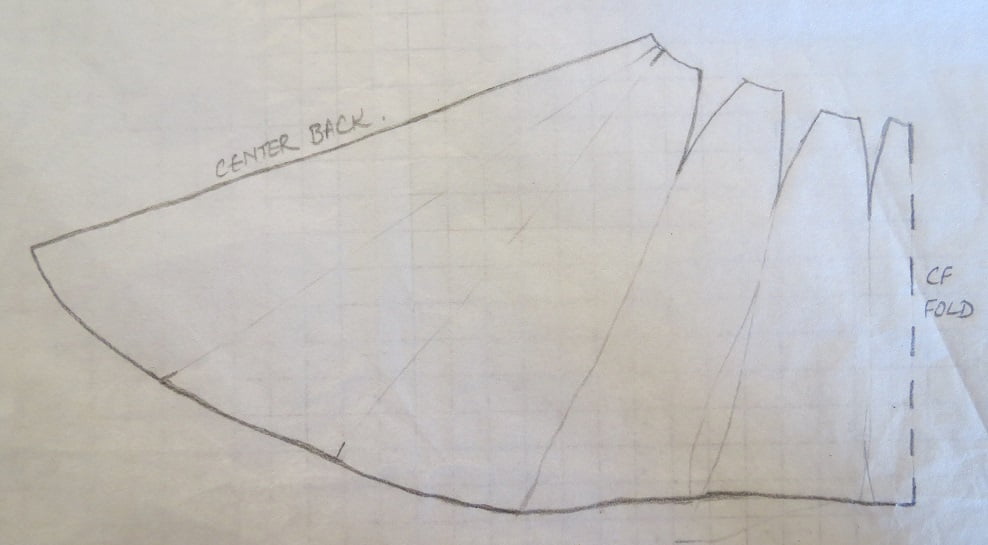Another embroidery sample arrived from India on Friday (left, seen against my own embroidery). As I compared it to the photos of the original dress in the museum, something began to dawn on me.
Isn’t it funny how you can look at a thing for years and assume it was done one way, but when you put it away for a while and get it out again, a lightbulb goes on and the answer suddenly becomes clear…
Remember how I was angsting about the seams when I first studied the dress? I couldn’t convince the custodians of the dress to let me study it flat on a table, so I had to try to figure out the skirt pattern just by looking at the dress in the glass case (above).
The seams delineating each panel shouldn’t be too difficult to see: the embroidery is dense, but I knew that the feather pattern would give it away. According to long-accepted tradition in embroidered costume, the pieces of the skirt would have been embroidered before assembly, so the edges of the feathers should run neatly along the seams.
So I looked and looked, but although there were plenty of feathers and plenty of edges and I had a good idea where they should be, I got very confused because I couldn’t find any seams. They were deliciously, perfectly invisible, except for the darts around the waist and hips, around which the pattern has been distorted to fit, and the extraordinarily clumsy center back seam, where the feathers didn’t even come together in line with each other (below).
The only evidence I could find of any other seam was this tantalising end-of-a-seam in the hem, which did not match up in any way with the embroidery into which it disappeared.
I wrote it off as a mystery. Either the ladies in the Worth workroom knew something that I don’t know about invisible couture seams, and someone clumsily altered the back seam at the last minute (none of us have ever made a change or finished fitting the dress five minutes before the ball, have we, right?), or the whole thing was embroidered in one piece, which was impossible because the embroiderers would have needed freakishly long arms. Indian zardozi embroiderers traditionally work at long, narrow frames, and yes, normally you could embroider a large piece by rolling the parts not being worked on over rollers at the edges of the work, but you’d need to roll them very tight to keep the working area taut, and this gorgeous three dimensional goldwork would be crushed by doing that.
No, my embroidery would be done on long, narrow pieces corresponding both to zardosi tradition and to the the long, narrow pieces I’d found on a suitable Edwardian skirt pattern of 1902.
I would have to painstakingly join the finished, embroidered pieces of the skirt by hand at the edges (because they mustn’t be crushed under a sewing machine foot), and then I’d have to finish some of the embroidered feather veins and eyes over the top, to hide the seams as invisibly as Worth did. Labour intensive, but that’s what embroidery is about, isn’t it?
BUT… the feather pattern doesn’t fit into the pieces of the skirt. If I try to draw correctly sized feathers to fit onto the skirt pieces, I end up with sections of wide feathers and sections of narrow feathers that make the skirt panels stand out distinctly from one another. The join in the skirt fabric that disppears invisibly into the work was machine sewn, and DIDN’T correpsond to the feathers. The feather pattern starts off beautifully at the front of the dress, and veers drunkenly off course as it travels in an unbroken progression towards the back, ultimately failing to meet properly at the centre back seam.
As I turned Sweta’s sample over in my hands, it dawned on me what’s happening here. This is about attitude – my attitude to my work, and their attitude towards theirs. To me, this is art. Painstaking months of art on my Holy Grail dress, priceless little stitches with lovely, delicate materials, to be minutely sewn by hand and really impress everyone with my insane handwork. It must be treasured, carefully stored, and must not be crushed during its creation.
To them, it’s a job that’ll take about three weeks. And actually, if you pad this sample embroidery reasonably well, I don’t think this stuff will crush as you wind it around a fairly big roller at the edge of an embroidery frame.
I think I’ve been completely overthinking this.
Sure enough, the skirt pattern I’ve developed from the Edwardian pattern and my observations of the Peacock Dress has curiously straight seams (excuse the quick sketch).
The skirt of the Oak Leaf dress, a gown made also by Worth in the same year for the same lady, laid curiously flat when the panels were joined… and the joins in the Peacock Dress skirt fabric don’t correspond to the embroidery? Suddenly it’s blindingly obvious.
Three or four widths of fabric were joined together in India by machine, and then embroidered as one.
I have asked Sweta what she thinks, and I have a funny feeling she’s going to say “Of course it would be done in one piece, idiot, what did you think you were going to do?”
So if I’m right, no angst-filled weeks lie ahead in which I wrestle the feather pattern to fit into the skirt pieces, and there’ll be no painstaking hand-joining of eleven narrow panels, except for a few darts and the back seam. It all becomes clear…








Hi Cathy
Great article. I have know the dress since I was little, living near to Kedleston and being involved in volunteer work with the Trust. There has always been debate over how the design was achieved. I have always thought it must, somehow, have been put together and then embroidered over the seems, as this would seem a more couture method and would give the beautiful finish. I will have a closer look at the back seem when I get a chance and pass this information on to the volunteers I know at the Hall.
Thanks
Jennyx
Yes! I notice that I never completed this story, Jenny, but Sweta got back to me with the answer. Yes, of course, she said, the fabric is joined into one large piece, and then it is mounted onto the frame with the excess rolled up at the edges… and we just work from the middle outwards.
D’oh! Of course! The embroidered part is never crushed in the rollers because they work from the centre outwards! *facepalm*
Hi cathy
Recently started following you.
Indian works are so fine.
I looked at a gujrati patola saree. And they prepare this saree by working on every part of threads.
They count and color perfectly (half centimeter)the threads then sew the saree. (That is their secret and no one in this world knows how they do that)
Because the have their own indigenous instruments.
In india fine works are preferred over any dress. The bridal dresses are covered with zardosi work most of time. You can follow tutorial on youtube. The peacock work is quite same. But around that green emerald the raised work needs a line of base under work to make it appear raised.
You can search zardosi work tutorial and most of times it is leaf like structure taught which is quite similar to peacock feather strycture.
There are different tutorials.
Their are faster ways too.
If you learn a faster way i dont think it will take more than one year to make that.